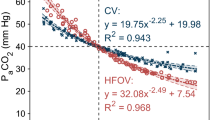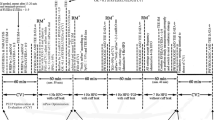Abstract
Effective gas exchange can be maintained in animals without endotracheal intubation using external high-frequency oscillation (EHFO). The aim of this study was to evaluate the effect of EHFO in patients with respiratory failure due to severe cardiogenic pulmonary edema. Seven patients were ventilated with EHFO for 2h at 60 oscillations·min−1, with a cuiras pressure of 36 cmH2O (−26 to +10) and an inspiratory to expiratory ratio of 1:1, with EHFO. Blood gas values and hemodynamic parameters were measured. Significant increases were noted in cardiac index (2.3±0.5 to 2.5±0.5 l·m−2;P<0.05), stroke volume index (24±7 to 28±8 ml·m−2;P<0.05), and arterial O2 pressure (Pao2) (70±4 to 95±23 mmHg;P<0.01) without a change in pulmonary artery wedge pressure at 1 h after EHFO. The respiratory rate decreased from 28±3 to 22 ±3 breaths·min−1 at 5 min after the termination of EHFO (P <0.01). Arterial CO2 pressure (Paco2) did not, however, decrease. Increased stroke volume without a change in pulmonary artery wedge pressure (preload) suggests either improved inotropic function of the left ventricle or reduced left ventricular afterload with EHFO. The use of EHFO may be effective not only for gas exchange but also for left ventricular function in patients with severe cardiogenic pulmonary edema.
Similar content being viewed by others
References
Katz JA, Marks JD (1985) Inspiratory work with and without continuous positive airway pressure in patients with acute respiratory failure. Anesthesiology 63:598–607
Buda AJ, Pinsky MR, Ingles Jr NB, Daughters II GT (1979) Effect of intrathoracic pressure on left ventricular performance. N Engl J Med 301:453–459
Baratz DM, Westbrook PR, Shah PK, Mohsenifar Z (1992) Effect of nasal continuous positive airway pressure on cardiac output and oxygen delivery in patients with congestive heart failure. Chest 102:1397–1401
Bersten AD, Holt AW, Vedig AE, Skowronski GA, Baggoley CJ (1991) Treatment of severe cardiogenic pulmonary edema with continuous positive airway pressure delivered by face mask. N Engl J Med 1991:1825–1830.
Foglio C, Vitacca M, Quadri A, Scalvini S, Marangoni S, Ambrosino N (1992) Acute exacerbations in severe COPD patients. Treatment using positive pressure ventilation by nasal mask. Chest 101:1533–1538
Meduri GU, Abou SN, Fox RC, Jones CB, Leeper KV, Wunderink RG (1991) Noninvasive face mask mechanical ventilation in patients with acute hypercapnic respiratory failure. Chest 100:445–454
Hayek Z, Peliowski A, Ryan CA, Jones R, Finer NN (1986) External high-frequency oscillation in cats. Experience in the normal lung and after saline lung lavage. Am Rev Respir Dis 133:630–634
Hardinge FM, Davies RJO, Stradling JR (1995) Effects of short term high frequency negative pressure ventilation on gas exchange using the Hayek oscillator in normal subjects. Thorax 50:44–49
Dolmage TE, De Rosie JA, Avendano MA, Goldstein RS (1995) Effect of external chest wall oscillation on gas exchange in healthy subjects. Chest 107:433–439
Penny DJ, Hayek Z, Rekington AN (1991) The effects of positive and negative extrathoracic pressure ventilation on pulmonary blood flow after the total cavopulmonary shunt procedure. Int J Cardiol 30:128–130
Penny DJ, Hayek Z, Rawle P, Rigby ML, Redington AN (1992) Ventilation with external high frequency oscillation around a negative baseline increase pulmonary blood flow after the Fontan operation. Cardiol Young 2:277–280
Zobel G, Dacar D, Rodl S (1994) Hemodynamic effects of different modes of mechanical ventilation in acute cardiac and pulmonary failure: an experimental study. Crit Care Med 22:1624–1630
Bohn DJ, Miyasaka K, Marchak BE, Thompson WK, Froese AB, Bryan AC (1980) Ventilation by high-frequency oscillation. J Appl Physiol 48:710–716
Rossing TH, Slutsky AS, Lehr JL Drinker PA, Kamm R, Drazen JM (1981) Tidal volume and frequency dependence of carbon dioxide elimination by high-frequency ventilation. N Engl J Med 305:1375–1379
Goldstein D, Slusky AS, Ingram Jr RH, Westerman P, Venegas J, Drazen J (1981) CO2 elimination by high-frequency ventilation (4 to 10 Hz) in normal subjects. Am Rev Respir Dis 123:251–255
George RJ, Winter RJ, Flockton SJ, Geddes DM (1985) Ventilatory saving by external chest wall compression or oral high-frequency oscillation in normal subjects and those with chronic airflow obstruction. Clin Sci 69:349–359
Zidulka A, Gross D, Minami H, Vartian V, Change HK (1983) Ventilation by high-frequency chest wall compression in dogs with normal lungs. Am Rev Respir Dis 127:709–713
Gross D, Vartian V, Minami H, Change HK, Zidulka A (1984) High frequency chest wall compression and carbon dioxide elimination in obstructed dogs. Bull Eur Physiopathol Respir 20:507–511
Chartrand DA, Phillips DM, Sun RY, Harf A, Chang HK (1987) Gas exchange and haemodynamics during high frequency body surface oscillation in rabbits. Bull Eur Physiopathol Respir 23:473–478
Hayes JK, Smith KW, David Port J, Jordan WS (1991) Comparison of tidal ventilation and high-frequency jet ventilation before and after cardiopulmonary bypass in dogs using two-dimensional transesophageal echocardiography. J Cardiothorac Vasc Anesth 5:320–326
Light RW, George RB (1983) Serial pulmonary function in patients with acute hearf failure. Arch Intern Med 143:429–433
Sharp JT, Griffith GT, Bunnell IL, Greene DG (1958) Ventilatory mechanics in pulmonary edema in man. J Clin Invest 37:111–117
Gherini S, Peters RM, Virgilio RW (1979) Mechanical work on the lungs and work of breathing with positive end-expiratory pressure and continuous positive airway pressure. Chest 76:251–256
Perel A, Williamson DC, Modello JH (1983) Effectiveness of CPAP by mask for pulmonary edema associated with hyper-carbia. Intensive Care Med 9:17–19
Weled BJ, Winfrey D, Downs JB (1979) Measuring exhaled volume with continuous positive airway pressure and intermittent mandatory ventilation. Techniques and rationale. Chest 76:166–169
Spitzer SA, Fink G, Mittelman M (1993) External high-frequency ventilation in severe chronic obstructive pulmonary disease. Chest 104:1698–1701
Author information
Authors and Affiliations
About this article
Cite this article
Takeda, S., Nakanishi, K., Takano, T. et al. Effect of external high-frequency oscillation on severe cardiogenic pulmonary edema. J Anesth 11, 83–87 (1997). https://doi.org/10.1007/BF02480066
Received:
Accepted:
Issue Date:
DOI: https://doi.org/10.1007/BF02480066




